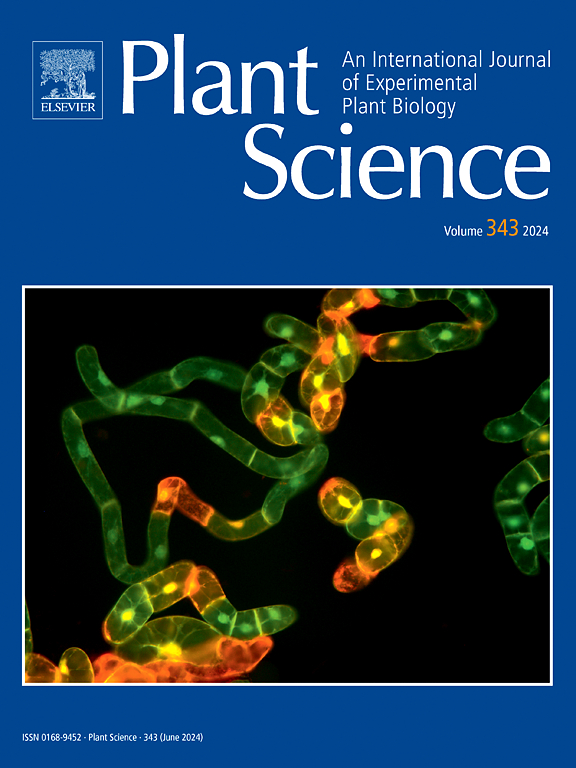测量拟南芥全株和幼苗的二氧化碳同化能力
IF 4.2
2区 生物学
Q2 BIOCHEMISTRY & MOLECULAR BIOLOGY
引用次数: 0
摘要
光合作用是植物合成生长和发育所需糖的重要过程,因此建立健全的光合作用监测方法非常重要。红外气体分析(IRGA)可通过测量植物的二氧化碳同化和释放来跟踪光合速率。虽然红外气体分析技术的开发取得了很大进展,但在拟南芥等小型草本植物上使用该技术时仍面临挑战。使用整株植物室可以克服在小巧精致的叶片上使用笨重的叶夹所带来的困难。然而,来自根部和土壤微生物的呼吸作用可能会影响这些气体交换测量结果。在这里,我们介绍了一种使用全植物室对大连茎叶植物有效进行 IRGA 的简单方法,这种方法可以消除根部呼吸和土壤微生物对测量结果的干扰。我们的研究表明,这种方法可用于检测一天中不同时间、不同生长条件下光合速率的微妙变化,以及野生型植物和光合机械缺陷植物之间的光合速率变化。此外,我们还展示了这种方法甚至可用于检测幼苗(如 10 d 大的幼苗)发育阶段光合速率的变化。这种方法为目前用于对三叶草进行 IRGA 的一系列技术做出了贡献,并可用于监测幼苗时期整株植物的光合速率。本文章由计算机程序翻译,如有差异,请以英文原文为准。
Measuring CO2 assimilation of Arabidopsis thaliana whole plants and seedlings
Photosynthesis is an essential process in plants that synthesizes sugars used for growth and development, highlighting the importance of establishing robust methods to monitor photosynthetic activity. Infrared gas analysis (IRGA) can be used to track photosynthetic rates by measuring plant CO2 assimilation and release. Although much progress has been made in the development of IRGA technologies, challenges remain when using this technique on small herbaceous plants such as Arabidopsis thaliana. The use of whole plant chambers can overcome the difficulties associated with applying bulky leaf clamps to small delicate leaves. However, respiration from the roots and from soil-based microorganisms may skew these gas exchange measurements. Here, we present a simple method to efficiently perform IRGA on A. thaliana plants using a whole plant chamber that removes the confounding effects of respiration from roots and soil-based microorganisms from the measurements. We show that this method can be used to detect subtle changes in photosynthetic rates measured at different times of day, under different growth conditions, and between wild-type and plants with deficiencies in the photosynthetic machinery. Furthermore, we show that this method can be used to detect changes in photosynthetic rates even at very young developmental stages such as 10 d-old seedlings. This method contributes to the array of techniques currently used to perform IRGA on A. thaliana and can allow for the monitoring of photosynthetic rates of whole plants from young ages.
求助全文
通过发布文献求助,成功后即可免费获取论文全文。
去求助
来源期刊

Plant Science
生物-生化与分子生物学
CiteScore
9.10
自引率
1.90%
发文量
322
审稿时长
33 days
期刊介绍:
Plant Science will publish in the minimum of time, research manuscripts as well as commissioned reviews and commentaries recommended by its referees in all areas of experimental plant biology with emphasis in the broad areas of genomics, proteomics, biochemistry (including enzymology), physiology, cell biology, development, genetics, functional plant breeding, systems biology and the interaction of plants with the environment.
Manuscripts for full consideration should be written concisely and essentially as a final report. The main criterion for publication is that the manuscript must contain original and significant insights that lead to a better understanding of fundamental plant biology. Papers centering on plant cell culture should be of interest to a wide audience and methods employed result in a substantial improvement over existing established techniques and approaches. Methods papers are welcome only when the technique(s) described is novel or provides a major advancement of established protocols.
 求助内容:
求助内容: 应助结果提醒方式:
应助结果提醒方式:


